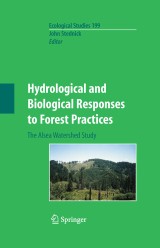Details

Hydrological and Biological Responses to Forest Practices
The Alsea Watershed StudyEcological Studies, Band 199
|
149,79 € |
|
| Verlag: | Springer |
| Format: | |
| Veröffentl.: | 03.12.2007 |
| ISBN/EAN: | 9780387690360 |
| Sprache: | englisch |
| Anzahl Seiten: | 322 |
Dieses eBook enthält ein Wasserzeichen.
Beschreibungen
The Alsea Logging and Aquatic Resources Study, commissioned by the Oregon Legislature in 1959, marked the beginning of four decades of research in the Pacific Northwest devoted to understanding the impacts of forest practices on water quality, water quantity, aquatic habitat, and aquatic organism popu- tions. While earlier watershed research examined changes in runoff and erosion from various land uses, this study was the first watershed experiment to focus so heavily on aquatic habitat and organism response to forest practices. The Alsea Watershed Study, as it came to be known, extended over 15 years with seven years of pretreatment calibration measurements, a year of treatment, and seven years of post-treatment monitoring. The research was a cooperative effort with scientists from Oregon State University, Oregon Department of Fish and Wildlife, the U.S. Geological Survey, and the U.S. Environmental Protection Agency. Cooperating landowners included the Georgia-Pacific Corporation, the U.S. Forest Service, and a local rancher. It was a remarkable 15-year partnership marked by excellent cooperation among the participants and outstanding coordination among the scientists, many of whom participated actively for the entire period.
The Alsea Watershed Study.- Effects of Timber Harvesting on Streamflow in the Alsea Watershed Study.- Stream Temperature and Dissolved Oxygen.- Forest Practices and Sediment Production in the Alsea Watershed Study.- Salmonid Populations and Habitat.- The Oregon Forest Practices Act and Forest Research.- The New Alsea Watershed Study.- Flynn Creek: Research Natural Area.- Long-term Streamflow Changes Following Timber Harvesting.- Long-term Water Quality Changes Following Timber Harvesting.- Risk Assessment for Salmon from Water Quality Changes Following Timber Harvesting.- Sedimentation Studies Following the Alsea Watershed Study.- Woody Debris from the Streamside Forest and its Influence on Fish Habitat.- Long-term Trends in Habitat and Fish Populations in the Alsea Basin.- The Alsea Watershed Study: A Comparison with Other Multi-year Investigations in the Pacific Northwest.- Watershed Management.- Research Opportunities in Hydrology and Biology in Future Watershed Studies.
<P></P>
<P>The Alsea Watershed Study, established in 1959 and reactivated in 1989 as the New Alsea Watershed Study, evaluated the effects of timber harvesting on water resources and salmonid habitat and populations in the temperate coniferous forests of the Oregon Coast Range. This was the first paired watershed experiment to focus on aquatic habitat and organism response to forest practices. Demonstrating the importance of maintaining streamside vegetation in protecting water quality and fish habitat during timber harvest operations, the study led directly to regulations in the Oregon Forest Practices Act of 1971 that required leaving streamside vegetation in harvest units. Decades of research have provided important information and lessons for watershed research and management.</P>
<P></P>
<P>Through analyses of works generated by the study, Hydrological and Biological Responses to Forest Practices: The Alsea Watershed Study addresses the quantification of forest resource sustainability and bolsters the case for long-term monitoring at a time when managers and policy makers are searching for ways to restore the runs of salmon and steelhead to rivers and streams of the Pacific Northwest. Edited by John D. Stednick, a forest hydrologist responsible for the study’s reactivation, this book will be of interest to students in natural resources, land managers, policy makers, and researchers, particularly in water and fishery resources.</P>
<P></P>
<P>About the Editor: John D. Stednick is a professor of Watershed Science at Colorado State University in Fort Collins, CO. </P>
<P>The Alsea Watershed Study, established in 1959 and reactivated in 1989 as the New Alsea Watershed Study, evaluated the effects of timber harvesting on water resources and salmonid habitat and populations in the temperate coniferous forests of the Oregon Coast Range. This was the first paired watershed experiment to focus on aquatic habitat and organism response to forest practices. Demonstrating the importance of maintaining streamside vegetation in protecting water quality and fish habitat during timber harvest operations, the study led directly to regulations in the Oregon Forest Practices Act of 1971 that required leaving streamside vegetation in harvest units. Decades of research have provided important information and lessons for watershed research and management.</P>
<P></P>
<P>Through analyses of works generated by the study, Hydrological and Biological Responses to Forest Practices: The Alsea Watershed Study addresses the quantification of forest resource sustainability and bolsters the case for long-term monitoring at a time when managers and policy makers are searching for ways to restore the runs of salmon and steelhead to rivers and streams of the Pacific Northwest. Edited by John D. Stednick, a forest hydrologist responsible for the study’s reactivation, this book will be of interest to students in natural resources, land managers, policy makers, and researchers, particularly in water and fishery resources.</P>
<P></P>
<P>About the Editor: John D. Stednick is a professor of Watershed Science at Colorado State University in Fort Collins, CO. </P>
Contains information gleaned from the original Alsea Watershed Study and the “new” study of 20 years later Includes analyses and syntheses of other relevant work, much of which originated from questions generated by the original study Represents the cooperative effort of many scientists from several disciplines. It comes at a time when mangers and policy makers are searching for ways to restore the runs of salmon and steelhead to rivers and streams of the Pacific Northwest Includes supplementary material: sn.pub/extras
Diese Produkte könnten Sie auch interessieren:

Decision Support Systems for Risk-Based Management of Contaminated Sites

von: Antonio Marcomini, Glenn Walter Suter II, Andrea Critto

96,29 €

Dynamics of Mercury Pollution on Regional and Global Scales

von: Nicola Pirrone, Kathryn R. Mahaffey

149,79 €














